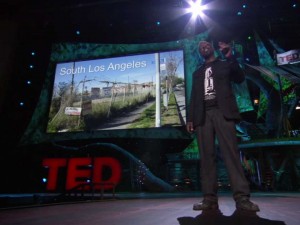Ron Finley delivered a brilliant TED speech by mixing sharp attitude, a passion for urban gardening and simple, powerful visuals.
A few years ago, Ron Finley stepped to the center of the TED stage in Long Beach, California and delivered a masterful presentation describing his mission to bring gardening and healthy foods to South Central Los Angeles. Ron has a lot of rough edges to him — especially by the standards of a typical TED audience. His voice and gestures have the attitude and cadence of a hip-hop performer. His words and slides were simple and direct. At times he swore. But Ron (who is not one of my clients) delivered his message as powerfully as any top-tier professional speaker I have ever seen or heard. It was a brilliant performance by both a gifted speaker and his visuals.
If you have not heard this particular TED talk I urge you to watch it — it is less than 11 minutes long. It illustrates so many of the visual techniques and qualities I coach speakers, from every skill level, to adopt. The really cool thing about these slides is they are simple and powerful. Anyone could have created them. No special design skill was required. All they or you have to do is to understand some simple concepts and have a cause to passionately believe in.
One note before you read on: These concepts and suggestions are directed to speakers preparing visuals for a short keynote style talk — maybe under an hour or so in length. Longer, workshop style presentations that seek to deliver quantities of detailed content require somewhat different visual presentation strategies.
How can you craft a great TED-level visual presentation?
1. Write a good speech first. You, and your insights, are the reason for the audience being there and wanting to hear your speech. The visuals should support your speech and your goals not draw attention away from them. Craft your speech without PowerPoint or any other visual program. Make sure it has the focus and the intensity that you want. Then add slides that support and enhance. Ron Finley’s speech was excellent even without visuals. The slides served to elevate his very good speech to an even higher level of connection.
 2. Use slides with big, bold images and simple words — they are often the perfect combination. Ron’s slides were extremely simple. He used full screen photos of his gardens and close-ups of the people that made them happen. When needed, short concise keywords were overlaid on the images. No special skills were needed to design these slides. The power and simplicity of the visuals helped keep the audience’s attention on Ron – where it belonged.
2. Use slides with big, bold images and simple words — they are often the perfect combination. Ron’s slides were extremely simple. He used full screen photos of his gardens and close-ups of the people that made them happen. When needed, short concise keywords were overlaid on the images. No special skills were needed to design these slides. The power and simplicity of the visuals helped keep the audience’s attention on Ron – where it belonged.
3. Let visuals do what they do best. (Hint: That’s not to just mirror your words)
- They can create a mood or backdrop for you to present against.
- They can tell wonderful stories. Our brains are hardwired to embrace and believe in stories. The earliest humans told tales of food, danger and bravery around their campfires and drew pictures in the dirt and on rocks. As an audience member, I felt immersed as Ron described and then showed how he transformed his urban spaces into an oasis of food.
 They can add a human dimension and build emotion. Not only did Ron’s slides show the real people that made these gardens, he enhanced the audience’s visceral connection by using images of cute kids helping out. It may be an easy trick but it almost always works!
They can add a human dimension and build emotion. Not only did Ron’s slides show the real people that made these gardens, he enhanced the audience’s visceral connection by using images of cute kids helping out. It may be an easy trick but it almost always works!- They can add humor. Ron’s first slideset was a humorous and spot-on sendup of the clumsy political system in Los Angeles.
- They can simplify the complex and show scale. Ron’s slide comparing the amount of city-owned abandoned land against the size of New York’s Central Park and then stating how that equals over 725 million tomato plants made the concept crystal clear. It gave a visual and mental scale to the numbers.
- They can elevate your professional appearance without you having to state it. Poorly designed or confusing slides make a speaker look amateurish. Ron’s “street wise” delivery together with his simple but powerful slides set him up as the no-nonsense expert of his world.
- They can add a visual channel to your oral delivery by repeating your content in a different format. Words and images appeal to our imaginations in different ways. Together they can help your ideas stick tightly in the minds of the audience.
Some final miscellaneous points:
- Master your material. Know the content of the slides, where they appear and how they interact with your audience.
- Master your technology. Nothing takes the enthusiasm out of the audience before you even get started like having to fiddle with the projector and laptop for 5-10 minutes because you were not properly set up. Get there early. Make sure your technology works seamlessly. It will add to your professional demeanor if you can step up and begin smoothly. Be prepared to deliver even if all the technology fails.
- Use a “clicker” to advance your slides. I usually have two different ones that I bring with me.
- Have a monitor or laptop within your line of sight so that you can see what is on the screen without having to turn and look.
- Bring multiple backups of your presentation on different types of media.
- Rehearse, rehearse and then rehearse some more. Remember: an amateur practices until they get it right; a professional practices until they can’t get it wrong.
- Although many speakers avoid using visuals and may even scoff at how dreadfully boring PowerPoint presentations can be, images can add much to the intensity and effectiveness of a short presentation. Slides can be a potent tool for the speaker if created and delivered correctly. The right combination of your words plus well thought out visuals can allow you to create a deep and powerful connection with your audience.
Give it a try.
